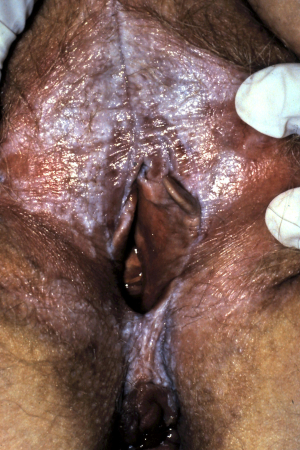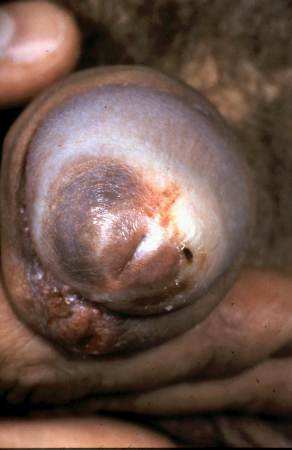History and exam
Key diagnostic factors
common
changes in skin color and/or texture
Patients with anogenital LS often present with both color and texture change in the affected area. Skin changes may include erythema (may be less prominent in darker skin tones), whitening (may be mistaken for vitiligo), crinkly/fine wrinkling of skin, and atrophy.[3] In some women, patches of whitening may become confluent and extend around the vulval/perianal skin, with a “figure of eight” appearance. Erosions, ulcerations, lichenification, hyperkeratosis, excoriations, and scleroses may also be present.[3]
Extragenital disease typically presents with atrophic white patches or plaques that are often asymptomatic, but sometimes may cause pruritus. Extragenital disease may involve any site on the body but is often found in flexural areas, the buttocks, thighs, breasts, trunk, and extremities.[11][36][Figure caption and citation for the preceding image starts]: Vulval lichen sclerosus showing white plaques and scarring with some loss of the labia minoraDalziel K et al. BMJ 2010; 340: c731; used with permission [Citation ends].
[Figure caption and citation for the preceding image starts]: Lichen sclerosus of glans penis in adult showing whiteness and purpuraDalziel K et al. BMJ 2010; 340: c731; used with permission [Citation ends].
purpura and/or ecchymoses
Purpura or ecchymoses are pathognomonic of anogenital LS and commonly arise due to scratching-related trauma secondary to pruritus. Purpura or ecchymoses may also develop due to trauma to affected skin during sexual intercourse or defecation.[57]
[Figure caption and citation for the preceding image starts]: Lichen sclerosus of glans penis in adult showing whiteness and purpuraDalziel K et al. BMJ 2010; 340: c731; used with permission [Citation ends].
pruritus
Pruritus is a common presenting symptom of anogenital LS in women and girls, but is a relatively uncommon finding in men and boys with anogenital disease.
One cross-sectional study of 503 women aged between 18 and 50 years with biopsy-confirmed LS found that symptoms of pruritus prompted 31% to seek medical attention.[46]
Extragenital disease is often asymptomatic, but sometimes may cause pruritus.
Pruritus, if present, is often worse at night and can disturb sleep.[35]
sclerosis/scarring and/or loss of normal anatomic structures
Architectural changes associated with LS in women with anogenital LS include clitoral hood fusion, labial fusion/resorption, narrowing of the introitus, anterior changes (may include the clitoral hood, often extending to midline agglutination of labia majora between clitoral unit and vestibule anterior to urethra; note that LS does not involve the clitoris), perianal involvement, and formation of posterior commissure bands.[3] In men/boys, LS may cause constrictive posthitis (foreskin tightening) and subsequently paraphimosis, meatal stenosis, phimosis, or painful erections/sexual dysfunction.[8][9]
Sclerosis (which may present as waxy and/or shiny areas of skin), scarring, and subsequent loss of normal anatomic structure may be seen in untreated anogenital disease and usually develop in the setting of chronic inflammation, often with silent progression.[58] Once scarring develops, it cannot be reversed.
[Figure caption and citation for the preceding image starts]: Vulval lichen sclerosus showing white plaques and scarring with some loss of the labia minoraDalziel K et al. BMJ 2010; 340: c731; used with permission [Citation ends].
dyspareunia and/or sexual dysfunction
Dyspareunia (painful intercourse), with or without tearing and/or bleeding during intercourse, can occur in sexually active women with anogenital LS at any time during the course of the condition, and may be attributed to active skin inflammatory changes (causing atrophy, erosions, or fissures) or, although there is no robust evidence to support this, has been postulated to be due to resulting nerve and muscular changes in the setting of a chronic overlying inflammatory condition.[40][47] Dyspareunia can also develop due to functional limitations associated with scarring.[40][46][47]
One cross-sectional study of 503 women with biopsy-confirmed LS found common presenting symptoms to include dyspareunia (68%) and tearing with intercourse or vaginal insertion (63%).[46] In one systematic review and meta-analysis, 59% of 486 women with LS reported sexual dysfunction.[47]
Like adult women, adolescent girls who are sexually active may also have symptoms of dyspareunia with associated lacerations at the base of the posterior fourchette due to trauma during intercourse.[7]
Men with untreated penile LS may develop sclerosis and narrowing of the foreskin, leading to phimosis or adhesions of the foreskin to the glans, which may lead to phimosis as well as sexual dysfunction/dyspareunia.[50] Older boys who are sexually active may also present with symptoms of dyspareunia.
fissures
Fissures appear as linear breaks in the skin, and may in some cases cause anogenital/vulval bleeding.
Other diagnostic factors
common
skin irritation and/or discomfort and/or pain
Women/girls with LS may commonly suffer with pain/burning/discomfort of the affected skin. The patient may describe “irritation.” This may cause difficulties with walking, sitting, and sexual intercourse, as well as causing issues such as anxiety and depression.[39][40][41][42][43][44]
Men with penile LS may have pain/discomfort of the affected skin as well as dyspareunia.
uncircumcised state
erosions
Erosions, due to intraepithelial loss of the dermis, are depressed, open circumscribed lesions that may affect the anogenital skin in patients with LS.
excoriations
Excoriations appear as scratches on the skin and may overlap with erosions or fissures.
Koebnerization
LS may appear in areas of trauma: for example, the condition may first appear in operative scars or occur in areas that are subject to mechanical trauma, such as due to tight clothing or from bicycle saddles in cyclists.[11][34] The precipitation of disease activity in areas of skin subjected to trauma is known as the Koebner phenomenon.
urinary dribbling and/or incontinence
dysuria
Dysuria can occur in untreated anogenital disease due to urine coming into contact with inflamed and fissured/eroded skin.
In the long-term, dysuria in men/boys can develop as a result of chronic scarring around the urethra.
In girls, dysuria may lead to a fear of voiding and subsequent overflow incontinence.[7]
uncommon
lichenification and/or hyperkeratosis
Thickening of the skin may present as lichenification and/or hyperkeratosis.
painful defecation
constipation
In girls, there may be a wide range of presenting complaints, including constipation and painful defecation due to anogenital skin lesions, which may lead to tearing and fissuring of the affected area.[7] Although this is a common finding in girls, women less commonly present with symptoms of constipation and/or painful defecation.[36]
anogenital and/or vulval bleeding
In women and girls, there may be a wide range of presenting complaints, including anogenital and/or vulval bleeding due to skin fissures.[7]
changes in urinary stream
In men, late-stage untreated genital disease may lead to scarring-related signs and symptoms such as changes in urinary stream due to meatal stenosis.[6]
Risk factors
strong
uncircumcised state
Circumcision is protective against penile LS in men; genital disease almost exclusively occurs in men who are uncircumcised.[31]
weak
family history
urinary incontinence (in men/boys)
Use of this content is subject to our disclaimer